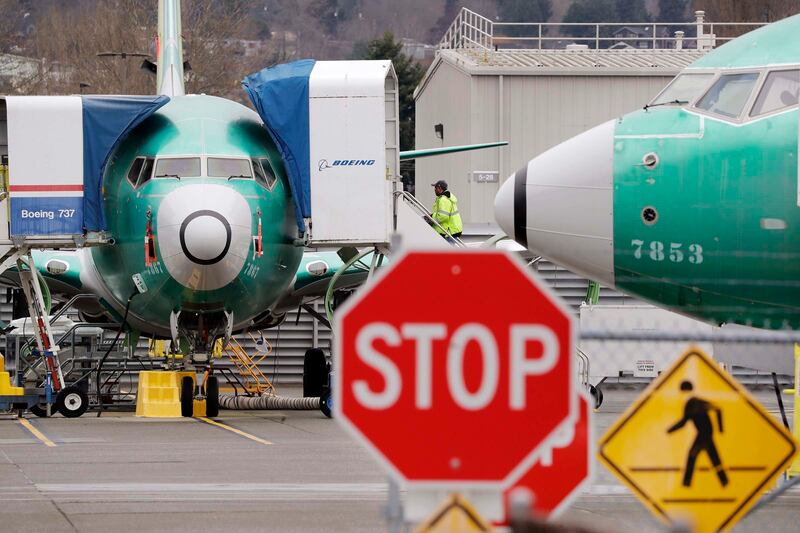SALT LAKE CITY — Chilling internal comments about the safety of Boeing 737 Max aircraft released to Congress last week have only added to the woes of the aerospace giant as hundreds of the planes remain grounded following deadly crashes in late 2018 and early 2019.
As of this month, Boeing suspended production of the fourth-generation version of the popular 737 single-aisle jetliner and last week announced the reassignment of thousands of Puget Sound-area employees who previously worked on the plane’s production. Just days later, a major 737 Max subcontractor, Spirit AeroSystems, announced it was furloughing 2,800 employees in the Wichita, Kansas, area as production of the planes came to a halt. Boeing employees in Utah, some of whom work on 737 Max components, will keep their jobs according to the company, though a spokesman said some may be temporarily reassigned to other projects.
A trove of Boeing internal documents released to Congress became public last Thursday and have raised further questions related to the safety of the 737 Max jets, which earned Federal Aviation Administration certification in 2017. One text exchange between two employees on Feb. 8, 2018, just eight months before a Lion Air jet crashed shortly after takeoff from Jakarta, Indonesia, referenced an atmosphere of dishonesty among Boeing staffers working on the 737 Max program and highlighted concerns about safety issues:
Speaker 1: “I don’t know how to refer to the very, very few of us on the program who are interested only in truth. But it’s mostly depressing that it’s so few.”
Speaker 2: “Honesty is the only way on this job — integrity when lives are on the line on aircraft and training programs shouldn’t be taken with a pinch of salt. Would you put your family on a MAX simulator trained aircraft? I wouldn’t.
Speaker 1: “No.”
Another 737 Max 8 went down just six minutes after taking off from Addis Ababa Bole International Airport in Ethiopia on March 10, 2019. Evidence from both that incident and the one in Indonesia pointed to flaws in the plane’s Maneuvering Characteristics Augmentation System that investigators believed was causing the planes to inadvertently nosedive. A global grounding of the aircraft followed, though Boeing continued production of the planes until last month.
Other communications in the internal documents reference deceptive practices and a hesitance to require anything beyond minimal training for pilots on the updated 737 Max systems, including the one questioned by crash investigators. In another employee-to-employee exchange, one speaker claimed the 737 Max was an airplane “designed by clowns, who in turn are supervised by monkeys.” Boeing issued an apology last week following public release of the communication records, which included emails and texts.
“We regret the content of these communications, and apologize to the FAA, Congress, our airline customers and to the flying public for them,” the statement reads. “We have made significant changes as a company to enhance our safety processes, organizations and culture. The language used in these communications, and some of the sentiments they express, are inconsistent with Boeing values, and the company is taking appropriate action in response. This will ultimately include disciplinary or other personnel action, once the necessary reviews are completed.”
The Boeing Co. has had a Utah presence for some three decades and currently has over 1,000 employees across facilities at Hill Air Force Base as well as in Layton, Salt Lake City and West Jordan that work on both commercial jets and defense contracts. Utah teams produce assembled components and flight deck structures for the 737 and 777 as well as the vertical fin and horizontal stabilizer for the 787 Dreamliner. The Max parts produced in Utah include the 737 flight deck consoles. Utah Boeing workers also build 32 small end-item assemblies including the pressure relief panels, parking brake mechanism and disconnect bracket panels for the 737.
Boeing represents a small slice of a significant and growing aerospace industry presence in Utah. According to the Governor’s Office of Economic Development, Utah-based aerospace and defense businesses employee over 30,000, and new ventures continue to be attracted to the state.
Chanel Flores, GOED’s director of information technology and aerospace/defense clusters, said in addition to expansion of commercial aircraft manufacturing facilities, Utah has been the beneficiary of Hill Air Force Base’s “multiplier effect.”
“We’re continuing to see growth and don’t see it slowing down,” Flores said. “Utah is very unique in that we have a heavy presence of defense contracts, thanks in large part to Hill Air Force Base. We’re seeing a lot of growth in aerospace and defense and, honestly, the biggest driver is Department of Defense contracts.”
Utah plays host to numerous companies in the aerospace and defense realm, including Albany Engineered Composites, BAE Systems, L-3 Communications, Lockheed Martin and Northrop Grumman. And specialized companies such as ACT Aerospace, Borsight, Janicki Industries and others contribute to the growing supply chain for both commercial and defense applications in the state.
As the primary custodian of the F-35 fighter jet, Hill Air Force Base and its 22,000 employees continue to be a propagating pivot point for the sector.
Juliette Tennert, director of economic and public policy research at the Kem C. Gardner Policy Institute, said Utah has achieved “critical mass” in aerospace and defense and would likely be able to absorb the downturn of a single entity.
“In Utah we have a competitive advantage to some extent in aerospace because of the activity that is currently here,” Tennert said. “We’ve achieved self-reinforcing growth through what we call the network effect.
“Boeing’s commercial aircraft side is having this trouble, but the company also does a decent amount of defense contracting, and that work is here as well. If there were continued stress in any one given company, there are other options for those employees, thanks to the fact that this industry is relatively large in Utah.”


